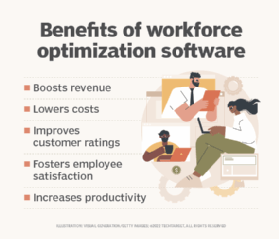
Getty Images/iStockphoto
5 benefits of workforce optimization in contact centers
In an industry with high turnover, contact center leaders must engage with their agents. Workforce optimization tools can help improve employee satisfaction and productivity.
Contact centers use workforce optimization applications to gather and analyze customer feedback and agent performance data. This analysis helps CX leaders find ways to improve agent performance and, ultimately, boost business metrics.
WFO describes a broad technology category that encompasses the applications, data and analytics that contact centers need to improve agent efficiency and overall operations. These tools overlap with workforce engagement management (WEM) systems, which include applications, rewards and training programs, to improve agent satisfaction and performance.
WFO platforms typically include voice of the customer (VoC) survey data, performance and quality management applications, and call and screen recording capabilities. Additionally, they offer agent, desktop, predictive, sentiment and speech analytics. Contact center supervisors can use these analytics tools to learn how customer feedback correlates with employee actions.
As WFO tools offer data-driven insights, they generate the following benefits, which include greater revenue and improved CX.
1. Increased revenue
Organizations that use WFO applications see an average revenue increase of 30.1%, according to Metrigy's "CX and Workforce Optimization" study of 524 companies. These organizations can analyze call and screen recordings and correlate their findings with VoC data to identify ways to improve agent performance. These features can boost customer service quality, but they can also help sales and customer service agents -- who increasingly have sales goals -- increase sales efficiency.
2. Reduced operational costs
WFO tools can reduce organizations' operational costs by about 1%, according to the same study. As organizations invest in these tools, they temporarily increase their costs on the technology itself. However, they don't need to pay managers to manually calculate performance data and associated improvement recommendations because the apps do it automatically. These organizations can also extend the tools' performance insights and recommendations to agents as part of their daily online training, which can reduce the number of supervisors a contact center needs.
3. Improved CX
The same study indicated that organizations that implement WFO software see a 41.8% increase in customer rating scores. This customer rating increase comes from the tools' ability to gather and analyze customer feedback. If contact center leaders act on this customer feedback, they can improve CX and get higher ratings.

4. Enhanced employee satisfaction
Organizations that use WFO software can expect to improve employee satisfaction by over 50%. Employees feel happier when they receive helpful feedback and coaching, which WFO platforms offer. A happy workforce correlates with high performance and low turnover. Companies that keep contact center agent turnover below 15% see a 26% increase in customer ratings.
Contact center agents experience more evaluation from their supervisors than most employees. For example, they get quantitative feedback daily concerning their performance. Employee experience dramatically improves when organizations couple employee feedback with gamification apps -- typically part of WEM. These apps inject friendly competition, weekly gift cards and quarterly bonuses into performance data to boost employee engagement.
5. Increased agent productivity
WFO software leads to a 37% efficiency increase for organizations that use it, according to Metrigy's study. Through performance management, call and screen recording features and ongoing training, WFO tools improve agent productivity in the contact center.
WFO tools can enhance overall employee experience for contact center agents. Doing so improves an organization's overall CX because happy employees offer quality service.







